Wikipedia:Picture of the day/January 2006
|
Featured picture tools: |
These featured pictures, as scheduled below, appeared as the picture of the day (POTD) on the English Wikipedia's Main Page in January 2006.
You can add an automatically updating POTD template to your user page using {{Pic of the day}} (version with blurb) or {{POTD}} (version without blurb). For instructions on how to make custom POTD layouts, see Wikipedia:Picture of the day.Purge server cache
January 1 - Sun
[edit]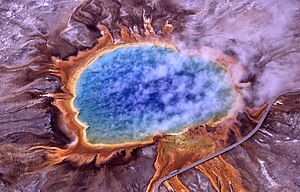
|
The Grand Prismatic Spring in Yellowstone National Park is the largest hot spring in the United States, and the third largest in the world, next to those in New Zealand. The vivid colors in the spring are the result of pigmented bacteria in the microbial mats that grow around the edges creating the greens, yellows, oranges, reds, and the bright blue in the center of the pool. Photo credit: Jim Peaco, National Park Service |
Text version ( view - edit - talk - history ) — Condensed version ( view - edit )
Mainpage version ( view - edit )
January 2 - Mon
[edit]
|
A dragonfly is a flying insect characterized by large multifaceted eyes, two pairs of strong transparent wings, and an elongated body. Dragonflies typically eat mosquitoes, midges and other small insects like flies, bees, and butterflies. They are usually found around lakes, ponds, streams, and wetlands because their larvae, known as "nymphs", are aquatic. Dragonflies do not bite or sting humans. In fact, they are valued as a predator that helps control the populations of insects that do. Photo credit: André Karwath |
Text version ( view - edit - talk - history ) — Condensed version ( view - edit )
January 3 - Tue
[edit]
|
Manila is the capital of the Philippines. The city is located on the eastern shore of Manila Bay on Luzon, the country's largest island. Despite widespread poverty, it is one of the most cosmopolitan cities in the world. It is the second most populous city in the Philippines, with more than 1.5 million inhabitants, but is also the hub of the Metro Manila area — a metropolis consisting of 17 cities and municipalities, with over 10 million people. Illustration credit: Seav |
Text version ( view - edit - talk - history ) — Condensed version ( view - edit )
January 4 - Wed
[edit]
|
"The Blue Marble" is a famous photograph of Earth. NASA officially credits the image to the entire Apollo 17 crew — Eugene Cernan, Ronald Evans and Jack Schmitt — all of whom took photographic images during the mission. Apollo 17 passed over Africa during daylight hours and Antarctica is also illuminated. The photograph was taken approximately five hours after the spacecraft's launch, while en route to the Moon. Apollo 17, notably, was the last manned lunar mission; no humans since have been at a range where taking a "whole-Earth" photograph such as "The Blue Marble" would be possible. Photo credit: The Apollo 17 crew |
Text version ( view - edit - talk - history ) — Condensed version ( view - edit )
January 5 - Thu
[edit]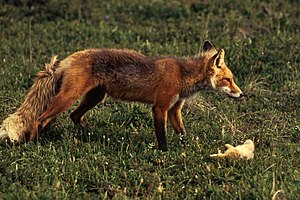
|
The Red Fox has the widest range of any terrestrial carnivore. They eat rodents, insects, fruits, worms, eggs, mice, and other small animals. They have 42 very powerful teeth that they use to catch their food. The foxes regularly consume from 0.5–1 kilograms (1–2 pounds) of food per day. Photo credit: U.S. Fish and Wildlife Service |
Text version ( view - edit - talk - history ) — Condensed version ( view - edit )
January 6 - Fri
[edit]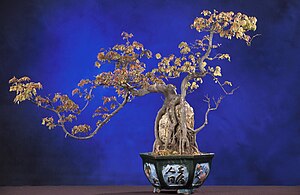
|
The art of bonsai originated from China over two thousand years ago, where it has been called penzai; it spread to Korea during the Tang or Song Dynasty (the 7th–13th century). As the Chinese art is intended for outdoor display the plants tend to be somewhat larger than seen in Japanese bonsai. A bonsai is not a genetically dwarfed plant; it is kept small by shaping and root pruning. Photo credit: USDA-ARS |
Text version ( view - edit - talk - history ) — Condensed version ( view - edit )
January 7 - Sat
[edit]
|
The Double-crested Cormorant is a North American member of the cormorant family of seabirds. Like all cormorants, it dives to find its prey, mainly fish, but also amphibians and crustaceans. This bird swims low in the water, often with just its neck and head visible, and dives from the surface. It uses its feet for propulsion and is able to dive to a depth of 1.5-7.5 m (5-25 feet) for 30-70 seconds. After diving, these birds spend long periods standing with wings outstretched to allow them to dry, since they are not fully waterproofed. Photo credit: Mdf |
Text version ( view - edit - talk - history ) — Condensed version ( view - edit )
Mainpage version ( view - edit )
January 8 - Sun
[edit]
|
McCoy Tyner is a jazz pianist from Philadelphia, Pennsylvania, best known for his work with the John Coltrane Quartet. Tyner joined Coltrane's group in 1960 and appeared on the saxophonist's popular recording of My Favorite Things. Tyner has recorded a number of highly influential albums in his own right. After leaving Coltrane's group, he began a series of post-bop albums released on the Blue Note label, starting with The Real McCoy in 1967. Photo credit: Gisle Hannemyr |
Text version ( view - edit - talk - history ) — Condensed version ( view - edit )
Mainpage version ( view - edit )
January 9 - Mon
[edit]
|
A barrel organ is a mechanical musical instrument made of a series of pipes, and bellows, like any other traditional organ, and of a cylinder studded with staples or bridges or pins corresponding in their placement to a particular tune. The continuous rotation of the barrel causes the staples to come into contact with levers and rods which open valves to let air from the bellows into the organ pipes. The bellows is usually actuated by the same power source which, through reduction gearing or worm gearing, causes the drum to slowly turn around. Photo credit: Chepry |
Text version ( view - edit - talk - history ) — Condensed version ( view - edit )
January 10 - Tue
[edit]
| |
| Night view of the Yarra River as it flows through the centre of Melbourne, with the central business district on the left and Southbank on the right. The river's source is a series of swamps in the upper reaches of the Yarra Ranges National Park, and travels 242 kilometres through southern Victoria before entering Melbourne's suburbs at Chirnside Park.
Photo credit: Diliff | |
Text version ( view - edit - talk - history ) — Condensed version ( view - edit )
January 11 - Wed
[edit]
|
The Tughra (طغراء) of Mahmud II. A tughra is a Turkish paisley-like calligraphic seal or signature used at the beginning of sultans' decrees. These colorful emblems incorporated the ruler's name and title in intricate vegetal inscriptions designed by neshanis, or court calligraphers. Parallel to the European signet, tughras often appeared on coins and stamps of the Ottoman Empire. Illustration credit: Baba66 |
Text version ( view - edit - talk - history ) — Condensed version ( view - edit )
January 12 - Thu
[edit]
|
Saint Vitus Cathedral in Prague, Czech Republic, is the seat of the Archbishop of Prague. It is located within Prague Castle and contains the tombs of many Bohemian kings. Although the current building was founded in 1344 by the Holy Roman Emperor, Charles IV together with Arnost of Pardubice, it wasn't completed until 1929 — almost 600 years later. Photo credit: Diliff |
Text version ( view - edit - talk - history ) — Condensed version ( view - edit )
January 13 - Fri
[edit]
|
Taking its name from a small, maneuverable fighting frigate, the first Chevrolet Corvettes were virtually handbuilt in Flint, Michigan. The outer body was made out of a revolutionary new composite material called fiberglass, offering the strength of steel without the weight. The tradition continues even today, as no Corvette has ever had anything other than a fiberglass outer skin. Photo credit: Softeis |
Text version ( view - edit - talk - history ) — Condensed version ( view - edit )
January 14 - Sat
[edit]
|
Melbourne is the state capital and largest city in the Australian state of Victoria, and the second largest city in Australia (after Sydney), with a population of approximately 3.8 million. The central business district (the original city) is laid out in the famous mile-by-half-a-mile Hoddle Grid, its southern edge fronting on to the Yarra River. Photo credit: Diliff |
Text version ( view - edit - talk - history ) — Condensed version ( view - edit )
Mainpage version ( view - edit )
January 15 - Sun
[edit]
|
Superconductivity is a phenomenon occurring in certain materials at low temperatures, characterised by the complete absence of electrical resistance and the exclusion of the interior magnetic field (the Meissner effect). The Meissner effect can be used to demonstrate superconducting magnetic levitation. Here a block of "high temperature" ceramic superconductor, cooled in a bath of liquid nitrogen, repels the round permanent magnet above. Flux pinning stops the magnet from sliding away. Photo credit: Pacific Northwest National Laboratory |
Text version ( view - edit - talk - history ) — Condensed version ( view - edit )
Mainpage version ( view - edit )
January 16 - Mon
[edit]
|
The plough is a development of the pick, and was initially pulled by oxen or humans, and later horses. Modern ploughs are, in industrialized countries, powered by tractors. Ploughing has several beneficial effects. The major reason for ploughing is to incorporate the residue from the previous crop into the soil. Ploughing also reduces the prevalence of weeds in the fields, and makes the soil more porous, easing later planting. Photo credit: Ralf Roletschek |
Text version ( view - edit - talk - history ) — Condensed version ( view - edit )
January 17 - Tue
[edit]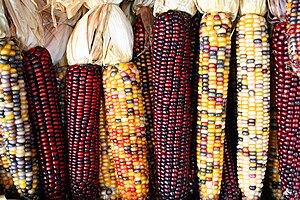
|
Maize is a cereal grain that was domesticated in Mesoamerica. Maize is grown in variety of cultivars, with many traditional varieties having predominantly blue colored ears, also known as blue corn. In 1983, Barbara McClintock received the Nobel Prize in Medicine for discovery of transposons while studying maize. Maize is still an important model organism for genetics and developmental biology today. Photo credit: Asbestos |
Text version ( view - edit - talk - history ) — Condensed version ( view - edit )
January 18 - Wed
[edit]
|
The natural range of the Marginated Tortoise is southern Greece, from the Peloponnesus to Mount Olympus. They are also found in isolated zones of the Balkans and Italy, with a somewhat broader range in northeastern Sardinia. The primary food for these tortoises are plants from their native Mediterranean region. Early in the morning, they leave their nightly shelter and bask in the sun to raise their body temperature. Then they go in search of food. In captivity, the primary foodstuffs are dandelions, clover and various varieties of lettuce. Photo credit: Richard Mayer |
Text version ( view - edit - talk - history ) — Condensed version ( view - edit )
January 19 - Thu
[edit]
|
Bentley Motors Limited is a British based manufacturer of luxury automobiles and Grand Tourers. Bentley Motors was founded in England on January 18, 1919 by Walter Owen Bentley. After a hayday of racing victories in the late 1920s, Bentley was sold to Rolls-Royce in 1931 and became subsumed as an alternative badge of the main Rolls-Royce line. In the 1980s Rolls began to distinguish the Bently marque as a high performance more sporty version of Rolls-Royce cars. A differentiation that has accelerated following the group's sale to Volkswagen AG. Photo credit: Dan Smith |
Text version ( view - edit - talk - history ) — Condensed version ( view - edit )
January 20 - Fri
[edit]
|
Sake is a Japanese alcoholic beverage, brewed from rice. In Japan, the word simply means alcoholic beverage. As with other alcohol in Japan, sake is poured with the palm of the hand facing down and the back of the hand facing up, particularly when it is poured for another person. Pouring with the palm of the hand facing up is considered rude and is likely to elicit surprise and disapproval. Photo credit: Dan Smith |
Text version ( view - edit - talk - history ) — Condensed version ( view - edit )
January 21 - Sat
[edit]
|
An airfield traffic pattern is a standard path followed by aircraft when taking off or landing at an airport.The pattern (or circuit) is used to coordinate air traffic, and differs from straight-in approaches and departures in that aircraft remain in close proximity to the airport. Circuits are usually employed at small general aviation (GA) airfields and military airbases. Illustration credit: Ericg |
Text version ( view - edit - talk - history ) — Condensed version ( view - edit )
Mainpage version ( view - edit )
January 22 - Sun
[edit]
|
The Carolina anole is an arboreal lizard found primarily in the southeastern parts of the United States and some Caribbean islands. This lizard can reach a total length of about 22 cm. Females are slightly smaller, around 16 cm. The male has a pink or red dewlap that can be extended from the chin as a courtship or territorial display. This dewlap display is often accompanied by head bobbing and "pushups." Photo credit: PiccoloNamek |
Text version ( view - edit - talk - history ) — Condensed version ( view - edit )
Mainpage version ( view - edit )
January 23 - Mon
[edit]
|
Unlike many insects, butterflies do not experience a nymph period, but instead go through four stages: egg, larva, pupa and imago. The adult butterflies have four wings, but unlike moths, the fore- and hindwings are not hooked together, permitting a more graceful flight. Some butterflies have evolved 'eyelike' markings on their wings, scaring off some birds, or allowing the butterfly a chance of escaping in the confusion when the bird simply pokes a hole in one of the wings. Photo credit: Fir0002
|
Text version ( view - edit - talk - history ) — Condensed version ( view - edit )
January 24 - Tue
[edit]
|
Crepuscular rays is a term used in atmospheric optics for rays of sunlight that appear to radiate from a single point in the sky. The name comes from their frequent occurrences during twilight, where the contrasts between light and dark are the most obvious. The rays are parallel, but appear to diverge because of linear perspective. They are often seen through sunlight shining through holes or breaks in cloud cover. Photo credit: PiccoloNamek |
Text version ( view - edit - talk - history ) — Condensed version ( view - edit )
January 25 - Wed
[edit]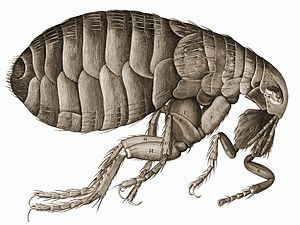
|
In most cases fleas are just a nuisance to their hosts, but some people and some animals suffer allergic reactions to flea saliva resulting in rashes, bites generally result in the formation of a slightly-raised swollen itching spot. However, fleas can transmit disease. One devastating example of this was the bubonic plague, transmitted between rodents and humans. In 1664 Robert Hooke's Micrographia was the first book to describe the microscopic world and included many of his highly detailed hand drawn illustrations such as this flea. Micrographia was a bestseller in its day. Illustration credit: Robert Hooke |
Text version ( view - edit - talk - history ) — Condensed version ( view - edit )
January 26 - Thu
[edit]
|
Mały Szyszak (Czech Malý Šišák, German Kleine Sturmhaube, literally Small Helmet) is a mountain in Poland, close to the border with Czech Republic. It is situated in the central (Silesian) part of the main mountain range of the Karkonosze, right above the village of Przesieka. Its peak is at 1436 m above sea level. Photo credit: Paweł Kuźniar |
Text version ( view - edit - talk - history ) — Condensed version ( view - edit )
January 27 - Fri
[edit]
|
Cockroaches are often found around garbage and in the kitchen. Female cockroaches, or henroaches, are sometimes seen carrying egg cases on the end of their abdomen. The eggs hatch from the combined pressure of the hatchlings gulping air and are initially bright white nymphs that continue inflating themselves with air and harden and darken within about 4 hours. Their transient white stage while hatching and later while molting has led to many individuals claiming to have seen albino cockroaches. Photo credit: Joăo Estęvăo A. de Freitas |
Text version ( view - edit - talk - history ) — Condensed version ( view - edit )
January 28 - Sat
[edit]
|
Bangkok, known in Thai as Krung Thep, is the capital and largest city of Thailand, with an official 1990 population of 8,538,610. Bangkok is one of the fastest-growing, most economically dynamic cities in Southeast Asia, but it suffers from major infrastructure and social problems as a result of its rapid growth. Air pollution is a significant problem, blamed on the city's massive traffic jams. The recent construction of elevated second-level expressways and the BTS Skytrains have eased the problem a little. Photo credit: Diliff |
Text version ( view - edit - talk - history ) — Condensed version ( view - edit )
Mainpage version ( view - edit )
January 29 - Sun
[edit]
|
A Manned Maneuvering Unit (MMU) is a jet pack (propulsion backpack that snaps onto the back of the spacesuit) which has been used on untethered spacewalks from NASA's Space Shuttle, allowing an astronaut to move independently from the shuttle. The MMU was used on three Shuttle missions in 1984. It was first tested on February 7 during mission STS-41-B by astronauts Bruce McCandless II (seen here) and Robert L. Stewart. Photo credit: NASA |
Text version ( view - edit - talk - history ) — Condensed version ( view - edit )
Mainpage version ( view - edit )
January 30 - Mon
[edit]
|
The planes that serve as Air Force One can be operated as a military command center in the event of an incident such as a nuclear attack. Operational modifications include aerial refueling capability, electronic countermeasures (ECMs) which jam enemy radar, and flares to avoid heat-seeking missiles. The heavily shielded electronics onboard include around twice the amount of wiring found in a regular 747. Photo credit: United States Air Force |
Text version ( view - edit - talk - history ) — Condensed version ( view - edit )
January 31 - Tue
[edit]
|
Morning glory is one of several annual, dicot, climbing plants of the following species, all belonging to the Convolvulaceae family and grown in blue, pink, purple, red, or white blooms. As its name implies, morning glory flowers open at morning time, allowing them to be pollinated by hummingbirds, butterflies, bees and other daytime insects and birds. The flower lasts for a single morning and dies in the afternoon. Photo credit: PiccoloNamek |
Text version ( view - edit - talk - history ) — Condensed version ( view - edit )
Picture of the day archives and future dates
